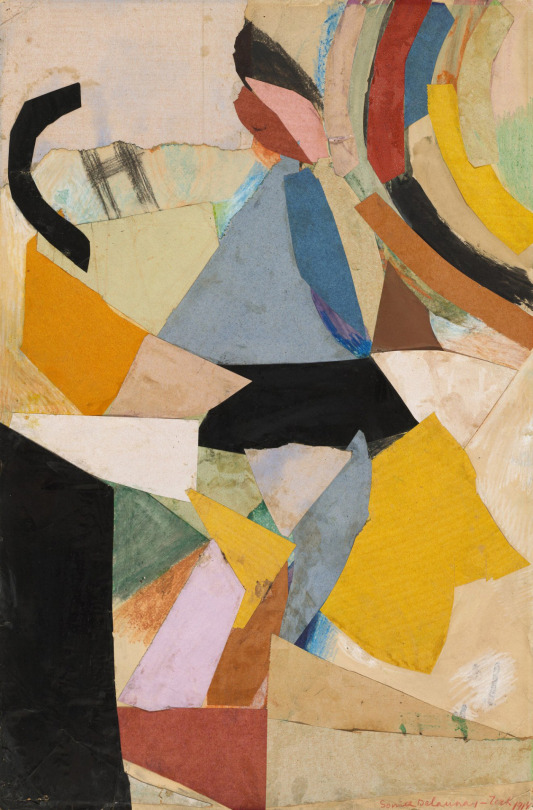A View Of Sintra, Portugal

A View of Sintra, Portugal
Artist: Cedric Morris (British, 1889-1982)
Date: 1950s
Medium: Oil on canvas
Collection: Private Collection, UK
Description
Among the numerous places Cedric Morris visited during his extensive travels, Portugal was one of his most frequented.
Morris’ first trip to Portugal, with his partner Arthur Lett-Haines and artist-plantswoman Primrose Harley, was in 1950. He returned many times, often in the company of the plantsman Nigel Scott; these trips were primarily plant-hunting expeditions, with the purpose of finding new species of plants native to the area, to add to their full and varied plant collection back home at Benton End, Hadleigh, Suffolk. Morris had always preferred the countryside, and after the war Morris and Lett-Haines had moved to Benton End from London, which included a large house, studio and garden.
More Posts from Art0634 and Others

Sonia Delaunay, “Solar Prism,” 1914,
Collage with additions in brush and ink, watercolor, and crayon,
Overall: 49.5 x 33 cm (19 ½ x 13 in.),
Courtesy: The National Gallery of Art

Circles connected with ribbons, 1914
Paul Klee

Painting - Jarda
Painting on paper,
acryl, pencil, pen and wax crayon,,
matt and high glos varnish,
mixed media, 28 x 46 cm

Arturo Avigdor - Female nude lying on the bed (1948)

Victor Servranckx, Opus 5 (Das Neue Frankfurt)., 1927
Oil on canvas
70 × 45 cm. (27 ½ × 17 ¾ in.)

Jean Metzinger
La Femme et l'oiseau , 1925

Jaipongan and coffee
2023
Noak Esbjörnsson

Ameisenhaufen
Artist: Marianne von Werefkin (Russian, 1860–1938)
Style: German Expressionism
Date: c. 1916
Medium: Oil and tempera on paper laid down on board
Collection: Private collection
Description
Marianne von Werefkin was one of the most remarkable women working at the centre of Munich’s avant-garde circle during a period of rapid change and intense creativity at the turn of the twentieth century. Born in the Russian town of Tula near Moscow in 1860, she studied art under the private tutelage of Ilya Repin. It was there that she met Alexej von Jawlensky in 1891, with whom her relationship as mentor, patron and companion would last until 1921. The couple moved to Munich in 1896, at which point Werefkin gave up painting for almost a decade in order to devote herself entirely to the development and promotion of Jawlensky’s talents. During this time, however, she played a decisive role in the Munich art scene as hostess of a salon on Giselastrasse, where she commanded the room of artists, writers, dancers, progressive thinkers and Russian émigrés who were attracted there.
After almost twelve months touring France with Jawlensky, Werefkin returned to painting in early 1907. The couple formed a close friendship with Wassily Kandinsky and Gabriele Münter, which led to the founding of a secessionist group called the Neue Künstlervereinigung München (New Association of Artists in Munich, NKVM) in 1909. The group’s spiritualist principles were founded on a desire to synthesise the impressions projected on the artist by the external world and the personal experience of this collected by the artist. The NVKM paved the way for the Blaue Reiter group, which would be created in 1911 in rejection of the former group by renegade members. Marianne von Werefkin, adhering artistically to Symbolism whilst belonging to the inner circle of the developing group, was the only artist close to the Blaue Reiter circle whose work focused on social issues and the world of human labour and factory work, and her figurative work became her defining point.

Otto Freundlich
Cosmic Eye (z.j.)
-
 villasugandhala liked this · 1 week ago
villasugandhala liked this · 1 week ago -
 impossibleomensphinx liked this · 2 weeks ago
impossibleomensphinx liked this · 2 weeks ago -
 gjtravell2a liked this · 2 weeks ago
gjtravell2a liked this · 2 weeks ago -
 klaustsstuff liked this · 2 weeks ago
klaustsstuff liked this · 2 weeks ago -
 art0634 reblogged this · 2 weeks ago
art0634 reblogged this · 2 weeks ago -
 art0634 liked this · 2 weeks ago
art0634 liked this · 2 weeks ago -
 birdsinmytree liked this · 2 weeks ago
birdsinmytree liked this · 2 weeks ago -
 kramott liked this · 2 weeks ago
kramott liked this · 2 weeks ago -
 allison-w liked this · 2 weeks ago
allison-w liked this · 2 weeks ago -
 anneowl2803 liked this · 2 weeks ago
anneowl2803 liked this · 2 weeks ago -
 casuallygreatcolor reblogged this · 2 weeks ago
casuallygreatcolor reblogged this · 2 weeks ago -
 speedyfortunewarrior reblogged this · 2 weeks ago
speedyfortunewarrior reblogged this · 2 weeks ago -
 speedyfortunewarrior liked this · 2 weeks ago
speedyfortunewarrior liked this · 2 weeks ago -
 misskiskis1 liked this · 2 weeks ago
misskiskis1 liked this · 2 weeks ago -
 artemlegere liked this · 2 weeks ago
artemlegere liked this · 2 weeks ago -
 20thcenturyartgallery reblogged this · 2 weeks ago
20thcenturyartgallery reblogged this · 2 weeks ago
